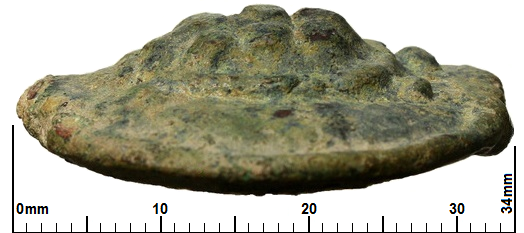
about ancient nomos
Ancient Nomos Art is a museum of galleries exhibiting ancient coins and ancient mint maps. The coin gallery displays the diverse art and history of hand-crafted ancient Greek, Roman, Byzantine, Persian and Medieval coinage. The ancient mints mapping gallery features Greek, Roman, Byzantine, Asia Minor and Medieval mint city regions and territories. Visitor's are welcome to explore, study and enjoy Ancient Nomos Art.

Roman Republic – 230 BC
Testudo Sextans
From Ancient Galleries

Obverse: Testudo seen from above with a nine scute plated shell, all on a raised disk.
Reverse: Rotum (wheel) made up with six equally divided spokes, all on a raised disk.
LEGEND
Obv: Testudo (Tortoise) seen from above with a nine scute plated shell, all on a raised disk. Rev: Rotum (wheel) made up with six equally divided spokes, all on a raised disk.
The early Roman cast bronze coin (Aes Grave) denominations were issued in fractions of twelve, based on the Roman libral (pound) of +/-330 grams. The above cast bronze testudo (tortoise) sextans is 42 grams representing a two-twelfths denomination (1/6 libra or As). This aes grave issue type is commonly known as the Wheel series. Other types include the Prow series (see Janus/Prow aes grave) and the Apollo series (see Apollo/Apollo aes grave). The Wheel series typically depicts a six spoked rotum symbol on one side and a symbolic animal image on the other side. Haeberlin notes, in his 1910 Aes Grave study; he examined 130 Wheel series coin specimens. Haeberlin’s weight range for the Wheel series sextans was between 34.30 through 62.50 grams. The numismatist Crawford, in his 1974 study, gives the series a date range of between 265-242 BC. More recent research by Italo Vecchi gives the date range to be after 230 BC (ICC 2013). The above coin animal symbol depicts a testudo (tortoise) viewed from above. The opposite side depicts the six spoke rotum wheel (perhaps a Campanian rotum). The ancient Roman testudo symbol represented the strong impenetrable protective defense, exemplified by the tortoise shell, its protective covering. The turtle shell significance was likely an important metaphorical symbol that represented the ancient Roman Infantryman Soldier’s “testudo formation” or tactical military position. The testudo tactical stance was a formation into a movable shelter with many overlapping shields held above their heads. This formed a defensive roof-like covering, in a group formation that protected all soldiers. When the Roman infantry maneuvered into the testudo formation, soldier’s would align their shields to form a tightly packed group all covered with their shields on the front and on top. This offered a completely protective “shell” which offered defensive strength against opposing enemy attacks. Like the tortoise shell, the testudo formation was an excellent protection against arrows and other flying objects. On the opposite side, the bronze sextans casting features the Roman rotum (wheel), centered on a raised disk with six equally spaced spokes. The six spoke rotum, as a symbol on coinage, likely represented the very important attribute of empire transportation, and its practical necessity for commerce and warfare. Several numismatists have suggested the early aes grave wheel series type meaning could be a reference to transportation in general, or specifically the completion of the Appian Way or other major Roman road construction project. Perhaps the six spoke wheel represented a convenient mathematical symbol for coinage in general, as an easily recognizable fractionally divided image of the Roman libral weight for bronze into 6 equal units.
DOCUMENTATION
Value: Sextans. Metal: Æ Bronze, “Aes Grave.” Weight: 42.00 grams (reduced Libral standard). Mint: Rome. Date: circa 230 BC.
Attribution: Crawford 24/7; ICC 71; Thurlow & Vecchi 35; Haeberlin, plate 25, 15-18; HN Italy 330; Sydenham, 63a; R. Russo, RBW Collection of Republican Coins, 37.
TESTUDO SEXTANS EDGE VIEW

SPECIAL FEATURE EXHIBIT
The ANAM Special Features gallery examines how the Republican Roman Testudo/Rotum sextans as “An Infantry Wage” symbolizes the impenetrable protective testudo (tortoise) shell, referring to the tactical Roman military formation of Soldiers, with shields raised above their heads, in a protective defense against enemy attacks. To view the Republican Roman Testudo/Rotum sextans study in the Special Features gallery, please use the following link: Testudo/Rotum Sextans Symbolism Special Features Exhibit
Legend, Documentation and Attribution
